The Indian state of Andhra Pradesh is known for so many things, including its age-old temples and other ancient shrines. Tiruptai Balaji is the first thing that comes to everyone’s mind while talking about the state. However, there are several other temples that are known for their huge religious significance. Located in Kurnool district, the Yaganti Temple is one such renowned Hindu temple, dedicated to Lord Shiva. Often referred to as Sri Yagantiswamy Temple, it has been built according to Vaishnavite tradition. Like other temples in the state, this one also experiences a huge visitor influx throughout the year.
Nestled amidst the scenic Yerramala Hills, this temple is famous for not only fascinating architecture but beautiful surroundings as well. There are several natural caves around the temple that were home to many saints over the centuries.
If you’re also planning to visit this temple on your trip to Andhra Pradesh, here's everything you need to know:
History
The history of Yaganti Temple dates back to the 15th century. It was constructed by King Harihara Bukka Raya of the Sangama Dynasty of the Vijayanagara Empire. According to a popular legend, Sage Agastya wanted to build a temple for Lord Venkateswara on the current site of this temple. However, the idol made for the temple could not be installed due to some kind of disfiguration. After this, Sage Agastya decided to perform a penance. This is when Lord Shiva appeared and told him that the site was better suited for a Shiva temple due to its resemblance to Mount Kailash. Sage Agastya then requested Lord Shiva to grant an idol of Goddess Parvati in a single piece of stone. Shiva agreed, and this is how the present idol of Sri Uma Maheshwara was formed.
Architecture
The main deities of this temple are Lord Shiva and Goddess Parvati. In this temple, Lord Shiva is worshipped in his idol form rather than in the form of Shivling. One major highlight of this temple is the stone-carved statue of Nandi, the sacred bull of Lord Shiva. It is believed that this statue has been continuously growing in size over all these years. A large number of local devotees say that initially the statue was much smaller in size. There are several different explanations for this. According to a popular legend, the stone Nandi would come alive at the end of Kali Yuga. According to the Archaeological Survey of India, on the other hand, the composition of the rock is the reason for this. This rock has a tendency to enlarge by nature, on its own.
The Yaganti Temple is also home to several caves. Some of the major ones are:
- Agastya Cave: It is believed that this is the place where Sage Agastya performed penance for Lord Shiva. There are a total of 120 steps leading up to the entrance of the cave. Currently, it houses an idol of Devi that is worshipped along with other idols in the temple.
- Venkateswara Cave: This cave houses the damaged idol of Sri Venkateswara. One foot of this idol got damaged before getting installed, so it could not be worshipped. You have to climb a few steep steps in order to reach this cave.
- Veera Brahmam Cave: This is believed to be the place where saint Sri Veera Brahmendra Swami wrote some of his Kala Gnanam.
Another important section of this temple is a small pond, also called Pushkarni. It is located in the centre of the temple. It is believed that there are five underground springs below the main Shiva Lingam in the main sanctum. Through these springs, the water flows from the main temple to the water pond (Pushkarni).
Best Time to Visit
Ideally, the best time to visit the Yaganti Temple is from October to March. Just like other hill stations in South India, Kurnool experiences a mildly cool climate during these months. With an average temperature ranging from 14°C to 28°C, the weather remains pleasant enough to enjoy sightseeing and other outdoor activities.
How to Reach
Being a popular pilgrimage site, the Yaganti Temple is easily accessible from all other parts of the country. Here is how you can get there:
- By Air: Located at an approximate distance of 290 kilometres, the Rajiv Gandhi International Airport in Hyderabad is the nearest one to the Yaganti Temple. You can easily find direct flights to this airport from almost every major Indian city. After reaching there, you can either take a bus or hire a private taxi to get to Yaganti.
- By Rail: The Nandyal Railway Station is the closest to the Yaganti Temple, with an approximate distance of 55 kilometers. It is well connected to major Indian cities, so you can easily find a number of trains to reach here.
- By Road: The Yaganti Bus Stand is the closest to the Yaganti Temple. Since it is located within walking distance, you can easily reach there without taking any public transportation.
Entry Timings
Like the majority of other Hindu temples, the Yaganti Temple also has fixed timing for devotees. You can visit the temple from 6 AM to 1 PM (morning) and from 3 PM to 8 PM (evening). Although these timings remain the same throughout the year, it is always recommended to check them once before visiting.
Accommodation
Despite being a popular choice among tourists, the area around Yaganti Temple offers several accommodation options. No matter what your budget is, finding a decent hotel room near Yaganti Temple should not be an issue. Here are a few good options you can consider to stay in Yaganti:
- Royal Country Resorts
- Tirumala Paradise
- KSR Residency
- Triguna Clarks Inn
- The Mourya Inn
Nearby Attractions
Here are a few nearby attractions that you can also cover on your trip to the Yaganti Temple:
- Kurnool Fort: Also known as Konda Reddy Fort, this magnificent structure is located in the heart of Kurnool district. Built by the Vijayanagara rulers, this fort dates back to the 17th century. Later, it became a part of the Golkonda Sultanate. In today’s time, Kurnool Fort is known for its huge historical significance and enthrals a large number of visitors.
- Sakshi Ganapati Temple: This is another famous temple in the region that has Lord Ganesha as its main deity. The main highlight of this temple is the idol of Lord Ganesh. It is considered unique because it holds a book and a pen in its hands. It is believed that Lord Ganesh records the names of the devotees who visit and keeps count of them. Other than being known for offering a great spiritual experience, this temple is also famous for its scenic surroundings. This is what makes it an equally popular spot among nature lovers.
- Oravakallu Rock Garden: The Oravakallu Rock Garden is another popular attraction near the Yaganti Temple. Located near the city of Kurnool, this place is famous for its unique rock formations, which are believed to be over 2500 million years old. Spread on a large area of approximately 1000 acres, this natural rock garden also features several small water bodies and landscaped gardens. If you want to spend a day away from the chaos of the main city, this is a place you should definitely visit.
- Srisailam Dam: Located near the town of Srisailam, this is a huge dam constructed across the Krishna River. It is one of the largest dams in India and currently serves as a multipurpose facility. Some of the major intended purposes are hydroelectric power generation, irrigation, and water supply. Besides this, Srisailam Dam also plays a major role in flood control during the monsoon season. Due to its scenic surroundings, this place also serves as a major vantage point. The beautiful views of Nallamala Hills you get from here attract a large number of people on a daily basis.
With the help of the above details, you can easily plan a visit to the Yaganti Temple in Andhra Pradesh. Or, if you don’t want the hassle of making all the travel-related arrangements, you can book an all-inclusive tour package. At Veena World, we offer an extensive range of Andhra Pradesh tour packages that you can choose from.
























































Post your Comment
Please let us know your thoughts on this story by leaving a comment.